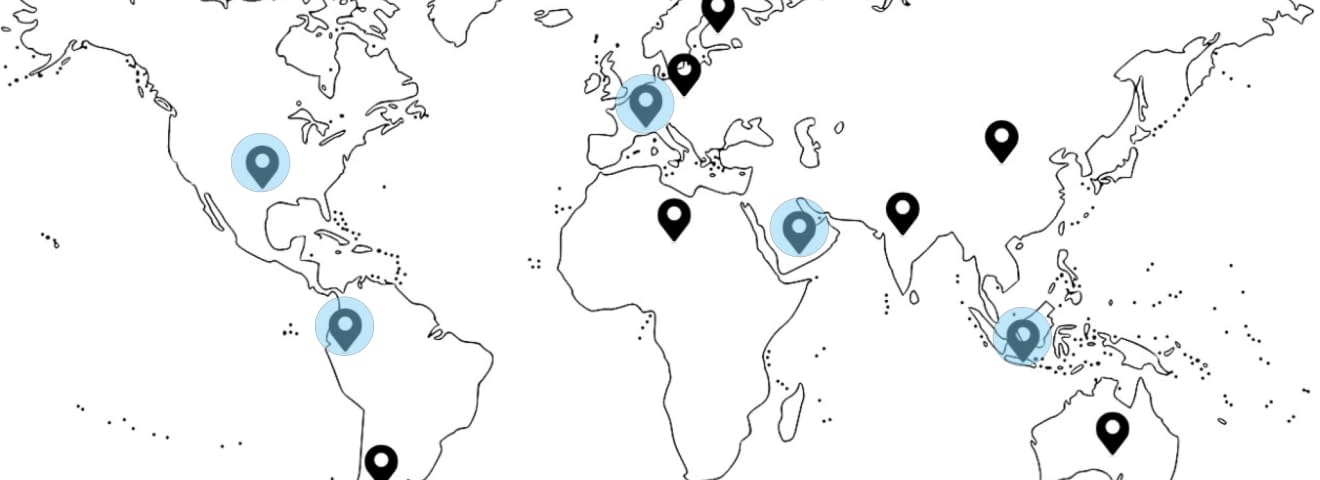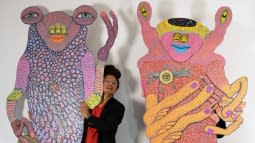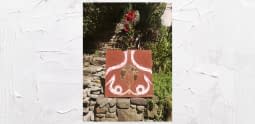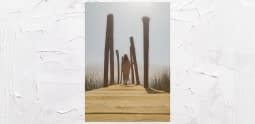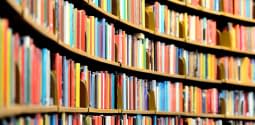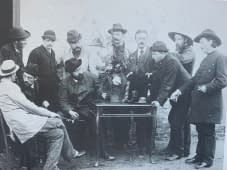The Encounter with Art: ART & INTERCULTURALITY - The creative dialogue between cultures by Cris (PART II)
Culture, like individuals, is constantly changing and in this sense ancient cultural traditions, new technologies and artificial intelligence coexist in an increasingly complex world. The intercultural artistic dialogue is also intergenerational, multidisciplinary and multifaceted.
In the second part of the article Art & Interculturality: The creative dialogue between cultures, we will listen to new voices in addition to the previous ones, in order to investigate, reflect and enrich our perspective on the relationship between art, interculturality and artists from different parts of the world.

Title:“Evolution”
Technique: Acrylic on canvas.
Size: 120 x 60 cm.
By Cris
Bern, Switzerland
Ketut Murtayasa from Indonesia / Asia
1. What does art mean to you?
The definition of art, in my opinion, is the expression of a feeling, which is expressed in various media, be it visual, lyrics, movement and so on.
2. What is the link that exists between your art and the culture of your country of birth, region in which you currently live or your continent of origin?
Art and culture or customs in my environment are interconnected. Supporting each other, especially in the social order of life in Bali, all aspects of life are always based on art and art is based on culture, and/or living habits influence art, and art influences the environment and living habits.
3. What does art contribute to the society of your current country?
Art makes a big contribution to life and the order of life of the people in Bali. Because every level and order of life in Bali is based on art, it influences all aspects of life, both in terms of economic turnover and everyday life thanks to the contribution of art.
4. Why do you make art and what inspires you?
I make works of art, perhaps because of the demands of my soul, which encourage me to convey a message. For one, I also want to preserve cultural heritage through works of art, amidst changes in civilization and times. Mythology, culture, habits of people's lives, life's problems and so on always inspire me to follow my soul's guidance, in my art.
5. Some words about art and interculturality that you would like to share.
Art is an expression of feelings expressed in many media in life, each soul will meet in the same feelings that are felt and seen.
The title "Tri Hita Karana" of my artworks which means: balance of relationships, among other things:
- Human relationship with God
- Human relations with humans.
- The relationship between humans and nature.

Title: “Tri Hita Karana”
Technique: Ink and Oil on canvas.
Size: 150 x 200 cm.
Bali, Indonesia
Madeleine Farhounmand from Switzerland / Europe
1. What does art mean to you?
Art, to me, is the manifestation of creativity – a fundamental and intrinsic aspect of our human existence. It serves as the life force that has not only propelled us as a species but also transcended cultural, religious, and societal boundaries. Throughout the course of human history, art has been a constant companion in our journey, allowing us to express our thoughts, emotions, and experiences in ways that words alone often cannot. It is a powerful means of communication, a universal language that bridges the gaps between individuals and cultures. Art has the remarkable ability to capture the essence of our shared humanity, serving as a testament to our capacity for imagination and innovation.
2. What is the link that exists between your art and the culture of your country of birth, region in which you currently live or your continent of origin?
My art reflects the interplay between the universal and the specific, inspired by my Swiss heritage and the global human experience. Switzerland's enduring neutrality shapes my creative journey, fostering a commitment to open dialogue and cooperation. I embrace diverse techniques without limitations, repurposing materials often discarded. Switzerland's role as a cultural crossroads, thanks to its central European location, instills in me a profound appreciation for the power of cultural exchange. Like Switzerland's diplomacy, my art bridges gaps, uniting different cultural perspectives, creating something transcending boundaries. In summary, my art connects the universal and the local, drawing from Switzerland's ethos of neutrality, cultural diversity, and breathtaking landscapes. It testifies to art's potential to transcend borders and serve as a medium for intercultural dialogue and understanding, much like Switzerland's reputation for peaceful diplomacy.
3. What does art contribute to the society of your current country?
Art is a vital force that enriches Swiss society, reflecting the universal and transcendent qualities of creativity. Switzerland's appreciation for art and culture is embodied by Art Basel, a globally renowned art fair symbolizing the nation's commitment to fostering cultural exchange and unity. Held in Basel annually, Art Basel showcases diverse artistic expressions from around the world, uniting artists, collectors, and enthusiasts in a spirit of peace. This event transcends geographical and cultural boundaries, echoing Switzerland's tradition of neutrality, offering a neutral platform for artistic exchange. In summary, art in Switzerland fosters cultural understanding, promotes diversity, and serves as a platform for intercultural dialogue through events like Art Basel. This mirrors Switzerland's core values of neutrality and peace, highlighting the profound potential of art as a powerful force for unity and intercultural exchange in our contemporary world.
4. Why do you make art and what inspires you?
I create art as a profound means to explore the spiritual dimensions of existence and connect with both my inner self and the world that surrounds us. The act of artistic creation is a spiritual journey, a superior experience that takes us beyond the boundaries of the everyday and provides a profound conduit for life's intricate stories. What inspires me is the universal language of art, one that transcends constraints and boundaries. This universal language allows us to express the deepest aspects of our humanity, serving as a bridge between the material and the spiritual realms. It resonates with our core essence and unites humanity in a shared exploration of our inner selves and the world we inhabit. In this creative process, I find the genuine purpose of our existence and a means to unveil the shadows of our vanity. Art is a vehicle for introspection, reflection, and communication, allowing us to express our most profound thoughts, emotions, and experiences. It is through this creative endeavor that I seek to contribute to the broader conversation of the human experience, transcending the limitations of language and culture.
5. Some words about art and interculturality that you would like to share.
Art, as a bridge between cultures, embodies universal qualities. It's a vessel for spiritual expression, unifying humanity by transcending divisions. The act of creating and experiencing art is a spiritual journey that connects us to something greater, emphasizing our interconnectedness beyond cultural backgrounds. Interculturality through art empowers individuals to embrace their heritage while celebrating diversity. It's a powerful tool for dialogue, promoting empathy and unity. In a world marked by division, art fosters connections and understanding. Art envisions a world where cultural diversity inspires strength, not division. It celebrates our shared humanity, promotes spiritual growth, and upholds values of peace, unity, and empowerment. Our differences become sources of beauty, creating a harmonious tapestry where every culture contributes its unique and vital role.

Title: “Transience of the Earthly Vanity of Man”
Technique: Acrylic on canvas.
Size: 60 x 60 cm.
Zurich, Switzerland
Monica Sarmiento Archer from United States / America
1. What does art mean to you?
Art was born in me as an inner need for reflection and analysis to understand the universe and its evolution and through art I have come to integrate my world within the academic field, cultural management and the creation of my own work.
2. What is the link that exists between your art and the culture of your country of birth, region in which you currently live or your continent of origin?
Through artistic expression, painting, sculpture and poetry I have expressed my concerns. An experience that on the one hand, is born from the study of nature and the human being, creating a language of my own. And on the other hand, to recognize the cultural identity of my country of origin, Ecuador in Latin America, with that great diversity of pre-Columbian cultures, each one with its own aesthetic and historical characteristics.
3. What does art contribute to the society of your current country?
Art is important because it transforms society. Artistic manifestations are part of culture, through them we can evidence the passage of civilizations, we can learn about customs and traditions and at the same time contribute to the development of future generations, they are the testimony of what we live, of what we are, of what we experience, they represent the mark we leave in time.
4. Why do you make art and what inspires you?
I started focusing on promoting my country Ecuador, the art of my mentor Master Estuardo and my own art, 2007 we created the Gallery CosmoArte Siglo XXV in Alicante, Spain where we started with projects of Latin American masters. Today we are consolidated and can present emerging artists. Also, in New York, through my work at bi/Coa (Base Intercultural / Community of the Americas), we have become a reference for cultural and academic projects with Latin America. We have an extraordinary team of professionals from all over Ibero-America, with whom we work enthusiastically and actively.
5. Some words about art and interculturality that you would like to share.
Throughout my life I have traveled all over the world, this has allowed me equal interaction, recognizing the great diversity of cultures. From New York and through my work in bi/Coa we have become a reference that generates shared cultural expressions, through dialogue and mutual respect working in constant intellectual and artistic training

Title:“Reflection I”
Technique: Stainless Steel
Size: 50 x 50 cm.
New York, United States
A DIVERSE CULTURAL WORLD DIALOGUING THROUGH ART
This research contributes to the intercultural encounter of the diverse societies of the world being art a bridge that communicates through forms, colours, textures and different techniques the visions of each artist and culture. In the artworks we can see the inner-outer reality of the artists, and we can also dream new realities as we immerse ourselves in their words made into paintings.

Title:“Inside & Outside”
Technique: Acrylic on canvas.
Size: 120 x 60 cm.
By Cris
Bern, Switzerland
In art we can find new ideas, original solutions and audacious approaches that allow us to face the great human problems, such as war, the climate crisis, technological disruption, social inequality the confrontation between cultures or the crisis of values. As we contemplate the diverse cultural manifestations of humanity, we enter our minds into new worlds and possible universes. To conclude this part II of the article and returning to the words of the German poet Johann Wolfgang von Goethe:
"We are preparing a paper on this subject, in which we intend to consider from an exclusively ethical perspective all the artists who are already known to us from other points of view, and to elucidate, from their themes and the treatment they would have given to their works, what the time and the place, the nation and the masters, as well as their own indestructible individuality contributed to make them what they were and to make them persevere in what they were." (J.W. von Goethe, “Maximen und Reflexionen”, 1833. Postum Edition, 2021, p. 33)

Fig. 1: Ketut Murtayasa & Cris at the Art-Studio in Tanah Lot, Bali, Indonesia. Photo Credit: ©CRIS / July, 2023.
The study of the artistic creations of different human societies introduces new meanings, symbols and concepts that enter into communication with already acquired knowledge. In this context, art has an essential transforming power, as it is a language full of nuances, sensibilities and freedoms.
As we tour the world's museums and art fairs, from MoMA in New York to Art Basel in Switzerland and the Qatar Museum of Islamic Art in the Middle East, as we investigate the works of the great masters of art or walk through the monumental artistic vestiges of past civilizations, we see artists playing a role in spreading culture, stimulating intercultural dialogue that allows us to transcend borders and find meeting points that foster a global culture of cooperation, solidarity and respect among human beings.

Fig. 2: Cris at the Museum of Islamic Art in Doha, Qatar, Middle East. Photo Credit: ©CRIS / August, 2023.
Each work of art inhabits the culture we live in and each artist by manifesting his own voice modifies himself and the environment he inhabits. The artists' voices express dreams, longings and stories that allow the viewers to approach their culture and their inner world of ideas, emotions and feelings.
Art and interculturality have a lot to offer in contemporary society since provide wonder, creativity and transformation in a real-virtual reality that changes permanently. This reciprocal dialogue between art and interculturality is part of the invaluable cultural capital of human diversity.
By Cris
Spezialist für Immigration and Interkulturelle Vermittlung
Bachelor in Internationalen Beziehungen
Schriftsteller and Künstler
Read here the first part "Art & Interculturality: The creative dialogue between cultures - PART I" of the article, where you can hear more voices from artists on the same five questions.
BIBLIOGRAPHIE UND QUELLEN
• J.W. von Goethe (1883). “Máximas y Reflexiones”. Postum Edition, 2021. Madrid España. ISBN: 978-84-350-9169-5.
